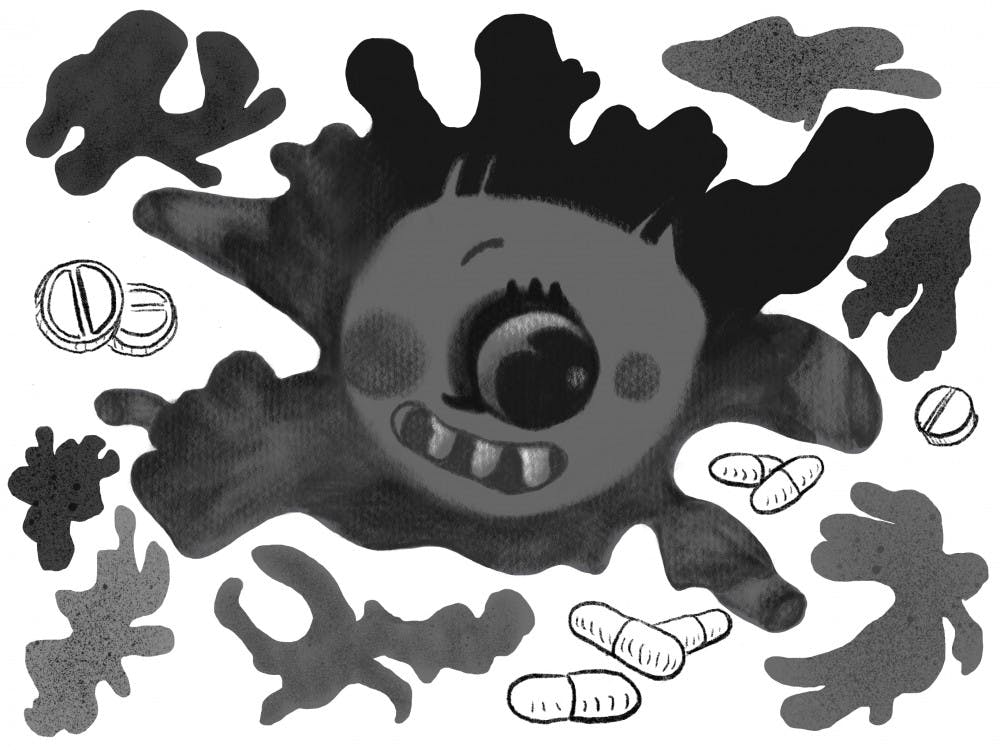When a person takes an antibiotic, which is intended to kill bacteria in the human body, the medicine can also wreak havoc on healthy bacteria inside the stomach.
A recent study by Peter Belenky, an assistant professor of molecular microbiology and immunology at the University, found a link between diet and the way the body reacts to antibiotics in mice. The bacteria that live inside the stomach are called the gut microbiome, and the food people eat may shape how the microbiome interacts with antibiotics, either lessening or increasing the often-damaging side effects.
According to Belenky, one of the key findings from the research was that antibiotics not only change the composition of the microbiome but also the manner through which the genes interact, which is part of the “transcriptional profile.” When antibiotics were administered to the mice, some of the genes in some of the bacteria inside the gut microbiome were altered in a way that changed the metabolic ability in the microbiome. Specifically, the altered genes changed the way the mice metabolized carbon sources, shutting down central energy metabolism pathways.
Damien Cabral, the lead author of the study, stated that bacterial metabolism is an important factor in the body’s response to antibiotics and its sensitivity to future treatment. It was found during the study that the most efficient way to alter the metabolic environment of the gut was to change diet. The researchers examined Bacteroides thetaiotaomicron, a specific bacterium present in guts, and were surprised to find the bacterium flourished during antibiotic treatment — its presence in the microbiome grew from 30 percent to 90 percent.
The team grew the bacterium in the lab, feeding it either glucose or dietary fiber. They found that the bacterium was ten times less affected by amoxicillin — one of the antibiotics used in the experiment — when fed dietary fiber as opposed to glucose.
These findings “tells us a lot about how the microbiome responds to antibiotics and that provides clues for how we can eventually extend this into therapy for people,” Belenky said.
The researchers used three commonly prescribed antibiotics — amoxicillin, ciprofloxacin and doxycycline. The research was conducted on mice because it is easier to find multiple mice with the same genetic background than multiple humans, said Swathi Penumutchu, one of the contributing researchers.
“If I studied a group of mice that I bought from the same place and then grew up together, their microbiomes are going to be very similar, so my baseline here is going to be very clean,” Belenkey said.
To potentially make the study more applicable to humans, researchers could take a human’s gut bacteria and place it in mice, Cabral said.
The team collaborated with experts from the Mayo Clinic, a nonprofit academic medical center, to analyze their results.
In the future, the researchers intend to further investigate the influence of dietary fiber on metabolic activity of the gut. Penumutchu, who is continuing the research after Cabral departs the lab, will look “at different diet-derived fibers from oats and psyllium husks and different fruits and vegetables” and examine how pure fiber supplements impact bacteria. The team is also interested in how people with metabolic disorders, like diabetes, would respond differently to antibiotics. Their ultimate goal is to be able to offer universally applicable dietary recommendations to people taking these antibiotics in a way that mitigates their disastrous side effects on the gut microbiome.
Belenky approached this research as he approaches all of his work — with a bird’s-eye philosophy inspired by Jim Collins, a core faculty member of the Wyss Institute for Biologically Inspired Engineering at Harvard. “(Collins) says a cell is like an electrical system, so let’s say you walk into a house and you don’t know how the wiring is made up, what you do is you walk room to room and you just flip the switches. And eventually you’ll figure out which switches connect to which light bulbs, and that’s kind of his perspective to the biology, except his idea is you want to flip all the switches at once so then you can figure out how the whole system works.”





